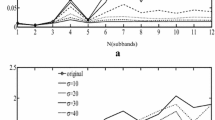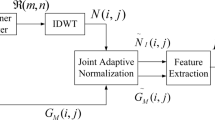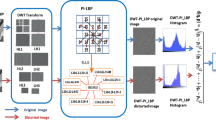Abstract
Objective quality assessment metrics that are consistent with human judgments of image quality, play an important role in many image processing applications. No-reference image quality assessment (NR-IQA) algorithms evaluate the quality of distorted images without any information about the reference images. In this paper, we propose an accurate and simple method for NR-IQA. In this method local binary pattern (LBP) operator is first applied to subbands of wavelet decomposed image separately; then histogram of LBP codes is calculated and concatenated to form quality aware features. Finally, support vector regression (SVR) is utilized to map the feature vectors to subjective quality scores. The experimental results for LIVE and TID2008 databases show that our proposed method is highly correlated to the subjective scores, and competitive to state-of-the-art NR-IQA methods.





Similar content being viewed by others
References
Chandler DM, Hemami SS (2007) VSNR: a wavelet-based visual signal-to-noise ratio for natural images. IEEE Trans Image Process 16:2284–2298
Chang C, Lin C (2011) LIBSVM: a library for support vector machines. ACM Trans Intell Syst Technol 2:27
Ciancio A, Da Costa ALNT, da Silva EAB, Said A, Samadani R, Obrador P (2011) No-reference blur assessment of digital pictures based on multifeature classifiers. IEEE Trans Image Process 20:64–75
Daugman J (1983) Six formal properties of two-dimensional anisotropie visual filters: structural principles and frequency/orientation selectivity. Trans Syst Man Cybern 5:882–887
Fan J, Liang RZ (2016) Stochastic learning of multi-instance dictionary for earth mover’s distance-based histogram comparison. Neural Comput Appl 1–11
Ferzli R, Karam L (2009) A no-reference objective image sharpness metric based on the notion of just noticeable blur (JNB). IEEE Trans Image Process 18:717–728
Field DJ (1993) Scale-invariance and self-similar “wavelet”transforms: an analysis of natural scenes and mammalian visual systems. Wavelets, Fractals, Fourier Transform Farge M, Hunt J, Vascillicos C, eds, Oxford UP 151–193
Golestaneh SA, Chandler DM (2014) No-reference quality assessment of JPEG images via a quality relevance map. IEEE Signal Process Lett 21:155–158
Li C, Bovik AC, Wu X (2011) Blind image quality assessment using a general regression neural network. IEEE Trans Neural Netw 22:793–799
Liang L, Wang S, Chen J, Ma S (2010) No-reference perceptual image quality metric using gradient profiles for JPEG2000. Signal Process Image Commun 25:502–5016
Marčelja S (1980) Mathematical description of the responses of simple cortical cells. J Opt Soc Am 70:1297
Mittal A, Moorthy AK, Bovik AC (2012) No-reference image quality assessment in the spatial domain. IEEE Trans Image Process 21:4695–4708
Moorthy AK, Bovik AC (2010) A two-step framework for constructing blind image quality indices. IEEE Signal Process Lett 17:513–516
Moorthy AK, Bovik AC (2011) Blind image quality assessment: from natural scene statistics to perceptual quality. IEEE Trans Image Process 20:3350–3364
Narvekar N, Karam L (2011) A no-reference image blur metric based on the cumulative probability of blur detection (CPBD). IEEE Trans Image Process 20:2678–2683
Ojala T, Pietikäinen M, Mäenpää T (2002) Multiresolution gray-scale and rotation invariant texture classification with local binary patterns. IEEE Trans Pattern Anal Mach Intell 24:971–987
Saad MA, Bovik AC, Charrier C (2010) A DCT statistics-based blind image quality index. IEEE Signal Process Lett 17:583–586
Saad MA, Bovik AC, Charrier C (2012) Blind image quality assessment: a natural scene statistics approach in the DCT domain. IEEE Trans Image Process 21:3339–3352
Sampat MP, Wang Z, Gupta S, Bovik AC, Markey MK (2009) Complex wavelet structural similarity: a new image similarity index. IEEE Trans Image Process 18:2385–2401
Sheikh HR, Bovik AC (2006) Image information and visual quality. IEEE Trans Image Process 15:430–444
Tang H, Joshi N, Kapoor A (2011) Learning a blind measure of perceptual image quality. In: IEEE Conf. Comput. Vis. Pattern Recognit. pp 305–312
Vapnik V, Golowich SE, Smola A (1997) Support vector method for function approximation, regression estimation, and signal processing. In: Adv. Neural Inf. Process Syst 9:281–287
Wang Z, Simoncelli EP, Bovik AC (2003) Multiscale structural similarity for image quality assessment. In: Thrity-seventh Asilomar Conf. Signals, Syst. Comput. pp 1398–1402
Wang Z, Bovik AC, Sheikh HR, Simoncelli EP (2004) Image quality assessment: from error visibility to structural similarity. IEEE Trans Image Process 13:600–612
Yammine G, Wige E, Kaup A (2010) A no-reference blocking artifacts visibility estimator in images. In: Image Process. pp 2497–2500
Ye P, Doermann D (2012) No-reference image quality assessment using visual codebooks. IEEE Trans Image Process 21:3129–3138
Zhang J, Le T (2010) A new no-reference quality metric for JPEG2000 images. IEEE Trans Consum Electron 56:743–750
Zhang L, Zhang L, Mou X, Zhang D (2011a) FSIM: a feature similarity index for image quality assessment. IEEE Trans Image Process 20:2378–2386
Zhang J, Ong SH, Le TM (2011b) Kurtosis-based no-reference quality assessment of JPEG2000 images. Signal Process Image Commun 26:13–23
Zhang M, Muramatsu C, Zhou X, Hara T, Fujita H (2015) Blind image quality assessment using the joint statistics of generalized local binary pattern. IEEE Signal Process Lett 22:207–210
Zhu J, Wang N (2012) Image quality assessment by visual gradient similarity. IEEE Trans Image Process 21:919–933
Author information
Authors and Affiliations
Corresponding author
Rights and permissions
About this article
Cite this article
Rezaie, F., Helfroush, M.S. & Danyali, H. No-reference image quality assessment using local binary pattern in the wavelet domain. Multimed Tools Appl 77, 2529–2541 (2018). https://doi.org/10.1007/s11042-017-4432-4
Received:
Revised:
Accepted:
Published:
Issue Date:
DOI: https://doi.org/10.1007/s11042-017-4432-4




